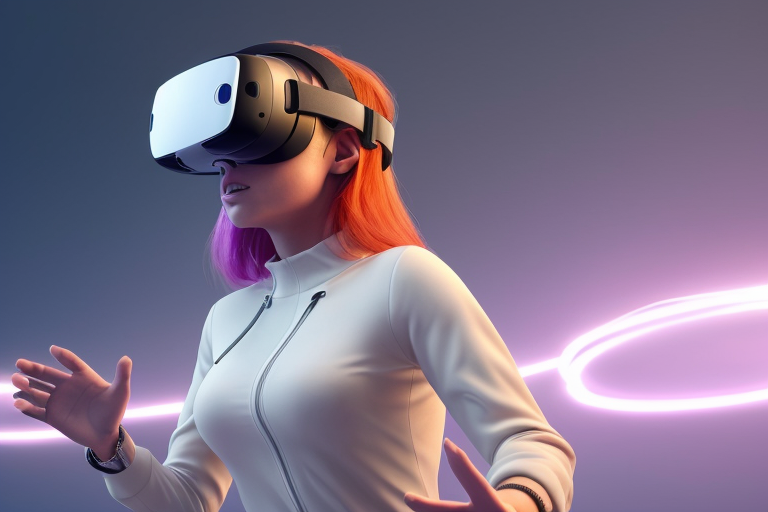Exploring the Latest VR Trends and Innovations
Virtual reality has come a long way since its inception in the 1960s. What was once a niche technology has now become a mainstream phenomenon, with millions of people around the world using VR devices for a variety of purposes. From gaming and entertainment to education and healthcare, virtual reality has the potential to revolutionize the way we interact with the world around us.
The purpose of this article is to explore the latest VR trends and innovations, and to provide readers with an in-depth look at the technology that is shaping our future. Whether you are a VR enthusiast or just curious about this exciting field, we hope that this article will provide you with valuable insights and information.
In the following sections, we will take a closer look at the evolution of virtual reality technology, the various industries that are using VR to enhance their operations, the challenges that are hindering widespread adoption, and the potential impact that VR could have on the future of entertainment and immersive experiences. We will also provide predictions for future VR trends and innovations, and offer our final thoughts on the potential of this exciting technology.
So, without further ado, let’s dive into the world of virtual reality and explore the latest trends and innovations that are shaping our future.
The Current State of VR and its Applications
Virtual reality has come a long way since its inception in the 1960s. With advancements in technology, VR has become more accessible and is being used in various industries. Healthcare, education, and tourism are just a few examples of industries that are utilizing VR to enhance their services.
In the healthcare industry, VR is being used for medical training and therapy. Uvanni, a company that specializes in VR healthcare solutions, has developed a VR program that helps patients manage chronic pain. The program uses immersive experiences to distract patients from their pain and reduce their reliance on medication.
In education, VR is being used to create virtual classrooms and field trips. Students can now experience historical events and visit different parts of the world without leaving their classroom. This technology has the potential to revolutionize the way we learn and make education more accessible to students who may not have the means to travel.
Tourism is another industry that is using VR to provide immersive travel experiences. VR headsets can transport users to different parts of the world and allow them to experience different cultures. This technology has the potential to change the way we travel and make it more accessible to people who may not have the means to travel.
Despite the potential benefits of VR, there are still challenges that come with its adoption. The high cost of VR equipment and software is a major barrier for many people. However, companies like Frankie’s VR Solutions are working on innovative solutions to make VR more affordable and accessible.
Accessibility is another challenge that comes with VR adoption. People with disabilities may not be able to use VR technology due to physical limitations. However, developers are working on solutions to make VR more accessible, such as using voice commands instead of physical controllers.
Finally, there is a lack of content and compatibility across devices. The quality of VR content can vary greatly, and it can be difficult to find high-quality content. Additionally, not all VR devices are compatible with each other, which can limit the potential of VR for immersive experiences. However, as more companies invest in VR technology, we can expect to see more high-quality content and improved compatibility across devices.
VR in Various Industries
Virtual reality is not just limited to gaming and entertainment; it has found its way into various industries, including healthcare, education, and tourism. In this section, we will explore how VR is being used in these industries and the potential benefits it offers.
VR in Healthcare
Medical professionals are using VR to provide immersive training experiences for medical students and healthcare professionals. VR simulations can provide a safe and controlled environment for medical students to practice procedures and surgeries. This technology can also be used to train healthcare professionals in emergency situations, allowing them to practice and improve their skills in a simulated environment.
VR is also being used as a form of therapy for patients with mental health conditions such as anxiety and PTSD. Exposure therapy, where patients are gradually exposed to their fears in a controlled environment, has been found to be effective in treating these conditions. VR provides a safe and controlled environment for patients to undergo exposure therapy, making it an ideal tool for mental health professionals.
VR in Education
Virtual reality is transforming the way students learn and experience education. VR technology allows students to visit places and experience things that would otherwise be impossible, such as exploring the depths of the ocean or visiting historical landmarks. VR can also provide a more immersive and engaging learning experience for students, making it easier for them to retain information.
Virtual classrooms are also becoming more popular, allowing students to attend classes from anywhere in the world. This technology has the potential to make education more accessible and inclusive, especially for students who live in remote areas or have disabilities.
VR in Tourism
Virtual reality is revolutionizing the tourism industry by providing immersive travel experiences for people who are unable to travel due to physical or financial limitations. VR technology allows people to explore different parts of the world from the comfort of their own home. This technology also provides a new way for travel companies to showcase their destinations and attract potential customers.
In addition to virtual travel experiences, VR is also being used to enhance real-world travel experiences. For example, some museums are using VR to provide visitors with a more immersive and interactive experience by allowing them to explore exhibits in a virtual environment.
The Impact of VR in Various Industries
The use of VR technology in various industries has the potential to revolutionize the way we learn, work, and experience the world around us. While there are still challenges to overcome, such as the high cost of equipment and software, the benefits of VR in these industries cannot be ignored.
Frankie Uvanni, a medical student, shared his experience with using VR in medical training. “VR has allowed me to practice procedures and surgeries in a safe and controlled environment, which has made me more confident in my abilities as a future healthcare professional,” he said.
However, there are also concerns about the potential negative impact of VR on certain industries. For example, the rise of virtual tourism could potentially harm the real-world tourism industry, leading to job losses and economic decline in some areas.
Predictions for the Future of VR in Various Industries
As VR technology continues to evolve, we can expect to see even more innovative uses of this technology in various industries. In healthcare, VR could potentially be used for remote patient monitoring and telemedicine. In education, VR could be used to create more personalized learning experiences for students. In tourism, we could see the rise of virtual travel agents who use VR to provide customers with personalized travel recommendations.
The potential uses of VR in various industries are endless, and as the technology continues to improve, we can expect to see even more innovative applications of this technology in the future.
Overcoming the Hurdles: Challenges in VR Adoption
Virtual reality has come a long way since its inception, but it still faces several challenges that hinder its widespread adoption. One of the most significant challenges is the high cost of VR equipment and software. While the price of VR headsets has decreased over the years, they are still relatively expensive, with high-end models costing upwards of $1,000. Additionally, the cost of VR software can be prohibitive, especially for small businesses and individuals.
Another challenge that VR faces is accessibility issues for people with disabilities. VR technology relies heavily on visual and auditory cues, which can be challenging for people with hearing or vision impairments. Additionally, VR headsets can be uncomfortable for people with mobility issues, making it difficult for them to use the technology.
Furthermore, the lack of content and compatibility across devices is another significant hurdle for VR adoption. While there are several VR games and experiences available, the selection is still limited compared to traditional video games and movies. Additionally, not all VR content is compatible with every VR headset, making it difficult for users to access the content they want.
Despite these challenges, there are efforts underway to overcome them. For example, some companies are developing more affordable VR equipment, making it accessible to a broader range of users. Additionally, there are efforts to make VR more accessible to people with disabilities, such as developing VR experiences that rely less on visual and auditory cues.
Moreover, there are efforts to increase the amount of VR content available and make it more compatible across devices. Some companies are developing software that can convert traditional video games and movies into VR experiences, making it easier for users to access content they already enjoy. Additionally, there are efforts to standardize VR technology, making it easier for developers to create content that works across multiple devices.
The Future of VR in Entertainment
Virtual reality has already made significant strides in the entertainment industry, with immersive experiences that transport viewers to new worlds and offer a level of interactivity that traditional media cannot match. However, the potential for VR in entertainment is just beginning to be realized, with new technologies and innovations emerging every day.
One of the most exciting areas of development in VR entertainment is gaming. VR gaming has come a long way since the early days of clunky headsets and limited gameplay options. Today, there are a wide variety of VR games available, from immersive first-person shooters to puzzle games that take full advantage of the 360-degree environment.
In addition to traditional gaming experiences, there are also new types of VR entertainment emerging, such as virtual escape rooms, where players must solve puzzles and work together to escape a virtual environment. These types of experiences offer a level of interactivity and immersion that traditional gaming cannot match, and they are only expected to become more popular in the years to come.
Another area where VR is poised to make a significant impact is in movies and other forms of visual media. While VR movies are still in their infancy, there are already some exciting developments in this area. For example, some filmmakers are experimenting with using VR to create immersive documentaries that allow viewers to experience different parts of the world in a new way.
There are also new types of VR experiences being developed for theme parks and other entertainment venues. For example, some theme parks are using VR to create immersive rides that transport visitors to new worlds and offer a level of interactivity that traditional rides cannot match.
Looking to the future, there are many exciting developments on the horizon for VR in entertainment. For example, some experts predict that VR will eventually replace traditional movie theaters, allowing viewers to experience movies in a fully immersive environment. Others predict that VR will become even more interactive, with the ability to touch and feel virtual objects becoming a reality.
Overall, the potential for VR in entertainment is vast and exciting. As technology continues to evolve and new innovations emerge, we can expect to see even more immersive and interactive experiences in the years to come. Whether it’s gaming, movies, or other forms of entertainment, VR is poised to revolutionize the way we experience media and offer us new and exciting ways to explore the world around us.









